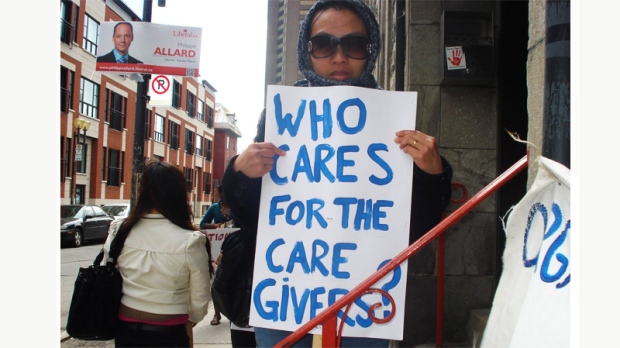by Yumna Siddiqi
As changes are being considered to the Live-In Caregiver Program that would increase eligibility requirements for participants, decrease the number of applicants accepted, and make it more difficult for participants to obtain permanent residency, it seems timely to reflect on the experiences of caregivers who are presently in the program.
B’s story, gleaned from a face-to-face interview, sheds light on some of the frustrations and challenges that caregivers experience because of restrictions on their mobility, an undervaluing of their prior experience and qualifications, and their vulnerability in their situations of work.
After graduating in the Philippines, B worked as a nurse in the Middle East. She said that she found working as part of a team in the pediatric care and the infectious diseases units at a hospital extremely rewarding. Encouraged by her sister, B decided to come to Canada in 2008, even though this meant giving up a career in nursing. She told herself that she would, after 24 months, be eligible to apply for permanent residence, and be able to find her way back to her original career track. In fact, the wait for permanent residence dragged on, and when we interviewed her, she had been waiting for nine months after submitting her application.
B said her job – which involved caring for two children and doing household chores – had been a good one, relatively speaking. This was because her employers did not require her to live in their home, and respected the hours stipulated in her contract, so she was able to work from 9 to 5. She said that most Filipina caregivers who are part of the LCP work from 6:30 a.m. to 11 p.m. because they are always on call, living as they do at their place of work. She said this was not only exploitative but also terribly stressful and damaging to their health.
While B was not asked to work extra hours, she found that the specific hours she was asked to work were frequently shifted at the last minute: “For me, I always wanted a good working relationship with my employer, so I have to give in most of the time, and it’s really hard.” Also, although she was supposed to work for a single employer, she was expected to work in the households of relatives and friends of her employer: “With the jobs as live-in caregiver, one thing really that I really disagree, but there’s nothing I can do about it, is, like, the employer can just give you to either his friend or their friend, or their parents’, their sister.” She found this difficult as she had to learn the particulars of each household. B said that most live-in caregivers put up with wage-theft, exploitative conditions, and worse, because they tell themselves that after 24 months they will be free to find other jobs. Here again, they are likely to be frustrated, B noted, because the regulations and processing times keep changing. And while they wait, they are not able to take academic courses, as B had hoped to do to requalify as a nurse.
In her time in Montreal, B has appreciated the support of the Filipina women’s organization PINAY, which she says really helps live-in caregivers. She is proud to be a member of PINAY.
Comments
